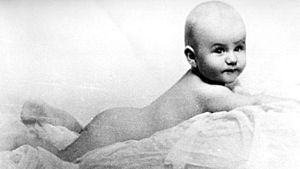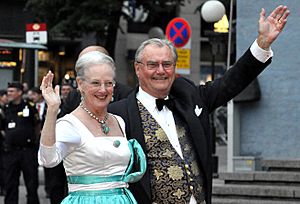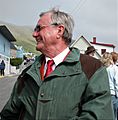Henrik, Prince Consort of Denmark facts for kids
Quick facts for kids Henrik |
|
|---|---|
| Prince Consort | |

Henrik in 2010
|
|
| Prince consort of Denmark | |
| Tenure | 14 January 1972 – 13 February 2018 |
| Born | Henri Marie Jean André de Laborde de Monpezat 11 June 1934 Talence, Gironde, France |
| Died | 13 February 2018 (aged 83) Fredensborg Palace, Denmark |
| Burial | 20 February 2018 Ashes partly scattered across Danish seas, partly interred in the private gardens of Fredensborg Palace |
| Spouse | |
| Issue |
|
| House | Monpezat |
| Father | André de Laborde de Monpezat |
| Mother | Renée Yvonne Doursenot |
| Religion | Church of Denmark prev. Roman Catholic |
| Military career | |
| Allegiance | |
| Service/ |
|
| Years of service | 1959–1962 (end of active service) |
| Rank | General (Army & Air Force) Admiral (Navy) |
| Battles/wars | Algerian War |
| Awards | Mentioned in dispatches Order of the Elephant Order of the Legion of Honour |
Prince Henrik of Denmark (born Henri Marie Jean André de Laborde de Monpezat; 11 June 1934 – 13 February 2018) was the husband of Margrethe II of Denmark. He served as her royal consort from when she became Queen on 14 January 1972 until his death.
Henrik was born in Talence, France, into an old French family called the Laborde de Monpezats. He spent his early years in Tonkin (now part of Vietnam), where his family had lived for many years. During World War II, his family stayed at their home in Cahors, France. They returned to French Indochina after the war. However, they had to leave after France lost the First Indochina War.
After finishing his education in France and Vietnam, Henrik served in the French Army during the Algerian War. Before marrying Margrethe, he worked in the diplomatic service. He married Margrethe on 10 June 1967. He became her prince consort when she became Queen of Denmark on 14 January 1972.
He had two sons, Crown Prince Frederik (born 1968) and Prince Joachim (born 1969). He also had eight grandchildren. During his time as prince consort, Henrik often said he was unhappy about never being called "king". Henrik was also a keen winemaker, making his own wine at his estate in France. He also published many poetry books. He was the first male consort to a Danish monarch. Henrik stopped his royal duties on 1 January 2016, at age 81. He died at Fredensborg Palace on 13 February 2018, after a short illness.
Contents
Early Life and Education
Henrik was born in Talence, Gironde, France. His parents were André de Laborde de Monpezat and Renée Doursenot. They got married in 1948. He had two younger brothers and two older sisters. He was raised as a Catholic.
He spent his first five years in Hanoi in Tonkin (now part of Vietnam). His father managed family businesses there. In 1939, his family returned to France and stayed there during World War II. Henrik was taught at home until 1947. Then, he went to a Jesuit school in Bordeaux.
He returned to Hanoi in 1950. Growing unrest in the area made him help protect his family's lands. He finished French secondary school in Hanoi in 1952. He originally wanted to study piano, but chose a different path. Between 1952 and 1957, he studied law and political science in Paris. He also studied Chinese and Vietnamese languages. He continued his studies in Hong Kong in 1957 and Saigon in 1958.
He served in the French Army during the Algerian War from 1959 to 1962. After that, he joined the French Foreign Ministry. He worked as a Secretary at the French embassy in London from 1963 to 1967. While there, he met Princess Margrethe, who was studying in London. They dated secretly for a year before Henrik proposed.
Marriage to Princess Margrethe
On 10 June 1967, he married Princess Margrethe. She was the heir to the Danish throne. The wedding took place at the Naval Church in Copenhagen. After the wedding, his name was changed to Henrik in Danish. He was given the title HRH Prince Henrik of Denmark. Before the wedding, he changed his religion to Lutheranism.
Queen Margrethe and Prince Henrik had two children: Crown Prince Frederik and Prince Joachim. They also have eight grandchildren.
Prince Henrik's first language was French. He quickly learned Danish after marrying Margrethe. He also spoke English, German, Chinese, and Vietnamese. Even though he learned Danish well, Danes often joked about his strong French accent.
His Role in the Danish Monarchy

When Queen Margrethe II became Queen, Henrik became the first male consort in Danish history. This meant there were no clear rules for his duties. He decided his own role would be to support and advise the Queen. However, he felt upset because he was not given the title of "king". He said there was no way to show the difference between his title and those of his sons and grandsons.
In 2002, Henrik left Denmark and went to stay at his family's Château de Cayx in France. He left because his son, Crown Prince Frederik, had hosted a New Year's Day reception when Queen Margrethe was away. Henrik felt "pushed aside, degraded and humiliated" because he was put in "third place in the royal hierarchy".
He explained, "For many years, I have been Denmark's number two. I have been satisfied with that role, but I don't want to be relegated to number three after so many years." Henrik went to France to think about his place in the Royal Family. Queen Margrethe flew to France to meet him. Henrik said that neither his wife nor his son were to blame. He stayed in France for three weeks. He did not attend the wedding of Willem-Alexander of the Netherlands and Máxima Zorreguieta. After three weeks, Henrik returned to Denmark.
On 30 April 2008, the Queen gave a new Danish title, "Count of Monpezat", to both of her sons. This title would be passed down through their male family members. The Queen's private secretary said they had thought about this for a long time. Henrik had even mentioned this idea in his book in 1996. He said it made him proud that "Monpezat" would be added to his grandson's name.
On 31 December 2015, Queen Margrethe announced that Prince Henrik would reduce his official duties starting on 1 January 2016. On 14 April 2016, Prince Henrik gave up the title of Prince Consort, which he had been given in 2005.
Interests and Hobbies
Prince Henrik loved art and culture, just like his wife. He especially liked wooden figures and jade. He collected them and showed them in a museum in 2017. Even though he didn't become a concert pianist, he played the piano throughout his life. In 2013, he played piano with the pop group Michael Learns to Rock for a song called "Echo".
Henrik wrote many poems in French, his native language. Some of these were published in books like Chemin faisant (1982) and Cantabile (2000). A musical piece called Cantabile was based on his poetry collection. It was performed by the Danish National Symphony Orchestra for his 70th and 75th birthdays. Henrik said that poetry helped him think deeply in a busy world. He felt poetry brought him closer to big questions like love, loneliness, and death.
Henrik was also a great cook, inspired by French cooking. He often planned family meals with the royal chef. He always used his own spices, some from his childhood in Asia. He also appeared on TV shows, demonstrating how he cooked meals at Fredensborg Palace or his French home, the Château de Cayx.
Death and Burial
In August 2017, Henrik announced that he did not want to be buried next to the Queen. He said this was because he was only named Prince Consort, not King Consort. This decision broke a tradition that started in 1559. Queen Margrethe accepted his decision.
On 6 September 2017, it was announced that Prince Henrik had dementia. On 28 January 2018, he was taken to the hospital after a trip to Egypt. Doctors found a harmless tumor in his left lung. His health got worse, so Crown Prince Frederik returned early from the 2018 Winter Olympics in Pyeongchang.
On 13 February 2018, Prince Henrik was moved from the hospital to Fredensborg Palace. The Royal Court said he wanted to spend his last days there. His condition remained serious. On 14 February 2018, it was announced that Prince Henrik had died in his sleep on 13 February. He was surrounded by his wife and sons.
After his death, the Court announced a month of royal mourning. Henrik's casket was placed in The Palace Chapel at Christiansborg. Over 19,000 people came to pay their respects. He was cremated after a funeral on 20 February. Half of his ashes were scattered in Danish seas, and the other half were placed in the private gardens at Fredensborg Palace.
Family and Children
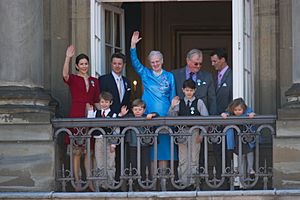
Prince Henrik had two sons and eight grandchildren. All of them were born in Copenhagen.
- Crown Prince Frederik (born 26 May 1968). He married Mary Donaldson on 14 May 2004. They have four children:
- Prince Christian (born 15 October 2005)
- Princess Isabella (born 21 April 2007)
- Prince Vincent (born 8 January 2011)
- Princess Josephine (born 8 January 2011)
- Prince Joachim (born 7 June 1969). He married Alexandra Manley on 18 November 1995. They divorced in 2005. He married Marie Cavallier on 24 May 2008. Joachim has four children:
- Count Nikolai (born 28 August 1999)
- Count Felix (born 22 July 2002)
- Count Henrik (born 4 May 2009)
- Countess Athena (born 24 January 2012)
In 2008, Queen Margrethe II announced that her male-line descendants would also use the title of Count or Countess of Monpezat. This was to honor Prince Henrik's family background.
Titles and Honours
| Coat of arms of Prince Henrik of Denmark | |
|---|---|
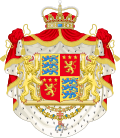 |
|
| Armiger | Prince Henrik of Denmark |
Titles and Styles
- Before 10 June 1967: Henri Marie Jean André de Laborde de Monpezat
- 10 June 1967 – 2005: His Royal Highness Prince Henrik of Denmark
- 2005 – 14 April 2016: His Royal Highness The Prince Consort of Denmark
- 14 April 2016 – 13 February 2018: His Royal Highness Prince Henrik of Denmark
Selected Honours
Prince Henrik received many awards and honours from Denmark and other countries. Here are a few:
National Honours
 Denmark:
Denmark:
 Knight of the Order of the Elephant
Knight of the Order of the Elephant Grand Commander of the Order of Dannebrog
Grand Commander of the Order of Dannebrog
Foreign Honours
 France:
France:
- Grand Cross of the Order of the Legion of Honour
 Germany: Grand Cross Special Class of the Order of Merit of the Federal Republic of Germany
Germany: Grand Cross Special Class of the Order of Merit of the Federal Republic of Germany Japan: Grand Cordon of the Order of the Chrysanthemum
Japan: Grand Cordon of the Order of the Chrysanthemum Norway: Grand Cross of the Order of Saint Olav
Norway: Grand Cross of the Order of Saint Olav Sweden: Knight of the Royal Order of the Seraphim
Sweden: Knight of the Royal Order of the Seraphim United Kingdom: Honorary Knight Grand Cross of the Order of the Bath
United Kingdom: Honorary Knight Grand Cross of the Order of the Bath
Images for kids
See also
 In Spanish: Enrique de Laborde de Monpezat para niños
In Spanish: Enrique de Laborde de Monpezat para niños


